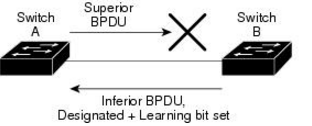Spanning Tree operation allows it to determine and compare configuration BPDU’s and see which one is better. The better BPDU is referred to as the superior BPDU, all other BPDUs that are compared are referred to as the Inferior BPDUs.
The following sequence of values are used by Spanning Tree to determine the superior BPDU:
- Root Bridge ID (RBID)
- The RBID value is compared and the lower RBID is determined to be superior
- Root Path Cost (RPC)
- If RBID values are the same, RPC is then compared, the BPDU with the lower RPC is declared superior
- Sender Bridge ID (SBID)
- If BPDUs have the same RBID, and RPC values SBID is compared, the BPDU with the lower SBID is declared superior
- Sender Port ID (SPID)
- If RBID, RPC, and SBID are all the same, the SPID values are compared, the BPDU with the lower SPID is declared superior
- Receiver Port ID (RPID, evaluated locally, this value is not sent in BPDUs)
- If all other values are the same, the BPDU from the lowest port ID is chosen, and that port is chosen as the Root Port
Each port in STP stores the superior BPDU it has sent or received. When the port stores the BPDU it must receive the same BPDU again within the MaxAge-MessageAge seconds interval, otherwise it will expire.
